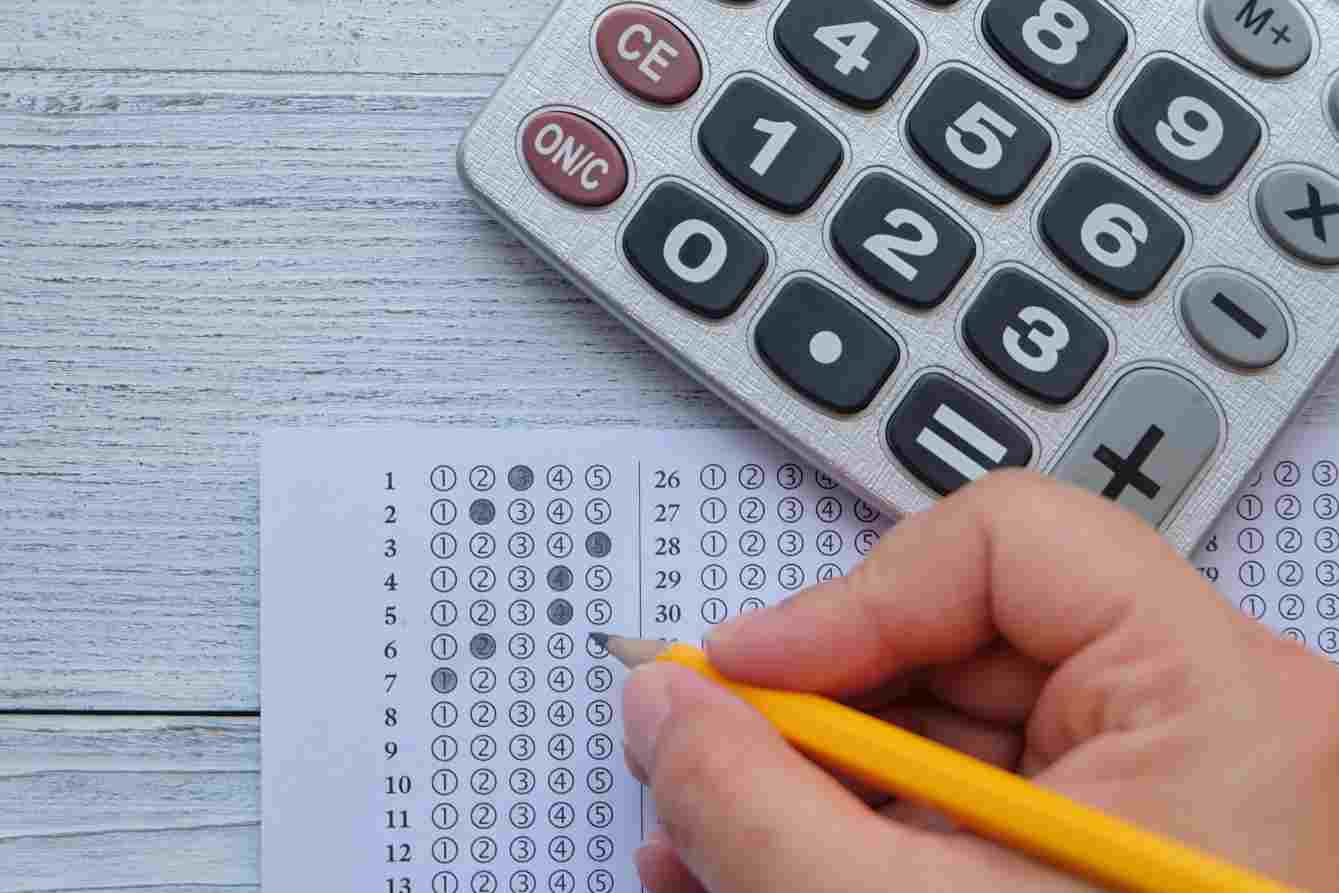Table of Contents
The road to your dream business school starts with the GMAT score chart. A good score indicates the student’s ability to not only get into a good business school but also how capable the student would be in coping with the demanding curriculum of the school and make it out of there successfully.
The GMAT score ranges from 200-800, whereas a good GMAT score is said to be between 700-760. The most common question that comes to a student’s mind is, “What is a good GMAT score?”. A good GMAT score depends on your target business school and on your profile. To understand what a good GMAT score is, let's first understand the various components that go into the making of the GMAT score and the GMAT score chart.
What is GMAT Score Chart
The GMAT Score chart explains how your scores on the Quant and Verbal sections map to your 800-point total score and also gives you insight into the areas that need improvement to raise your total GMAT score. Your GMAT score is calculated from your combined performance on the Quant and Verbal sections of the GMAT.
The GMAT Quant and GMAT Verbal sections are scored on a scale of 6 to 51. Your GMAT Integrated Reasoning (1 to 8) and GMAT Essay (0 to 6) section scores do not factor into your Total GMAT score. The GMAT score chart has undergone a tremendous change over the years.
In the present scenario, as you approach the perfect score, i.e., scoring 780, 790 or 800 now requires a higher scaled score as compared to in the past. The updated GMAT score chart now looks like this.
A composite GMAT score is determined by combining your subscores in the Quantitative Reasoning and Verbal Reasoning sections. Each section is scored on a scale of 6 to 51 points, and the composite score is based on 200 to 800 points. The GMAT is an adaptive test, which means your scores are not solely based on the number of questions you answer correctly. Now that we have the GMAT Score Chart let us look into the GMAT Percentile Chart.
GMAT Score Chart
With your GMAT preparation, you must also have proper info on the GMAT score chart. In many instances, students get confused on score conversion where GRE instead of GMAT is submitted or needs a particular curt of. for GMAR score. To avoid any confusion, familiarise yourself with the score chart of the GMAT to calculate and be precise.

GMAT percentile is the comparison of your total score to that of the students who took the exam within the last three years. GMAT percentile reveals how you have fared when compared to the rest of the applicants. The percentile rank of your score is the percentage of scores that is in its distribution or are lower than it. You can calculate your GMAT percentile with the help of the table below:
| Score | GMAT Percentile |
| 760-800 | 99% |
| 750 | 98% |
| 740 | 97% |
| 730 | 96% |
| 720 | 94% |
| 710 | 90% |
| 700 | 88% |
| 690 | 85% |
| 680 | 82% |
| 670 | 80% |
| 660 | 78% |
| 650 | 73% |
| 640 | 68% |
| 630 | 66% |
| 620 | 62% |
| 610 | 58% |
| 600 | 55% |
How is the GMAT Score Calculated

The GMAC administers real GMAT tests using a very specific adaptive algorithm. In other words, your response to each experimental question determines the difficulty level of the next question you are asked on your test. Depending on the difficulty level of the question, the marks for each answer vary. There are two types of score reports:
Unofficial Score Report: As soon as you complete the test, you'll receive it. If you don't accept your score, you'll have two minutes to cancel it. For $25, you can cancel your score online within 72 hours of the scheduled start time of your exam.
Official Score Report: You'll receive this report within 20 calendar days. This report includes scores for all sections of the GMAT. It includes all your test scores except for AWA.
When it comes to the GMAT, your score is determined by the difficulty level of questions you get wrong and not how many errors you make. So if you forget twelve easy issues on the Quant section, then your grade would be in the 20s or 30s; but if you got 12 difficult ones wrong, then this could result in as high a score as 47Q or even 48Q.
The same goes for Verbal, although it is slightly more sensitive to the number of incorrect answers. This is because it's hard to come up with very challenging verbal questions in comparison to Quant items, which can be increased and decreased easily.
How to Calculate Your Score
GMAT composite scores are calculated based on your verbal and quantitative scores. Although the exact formula for calculating GMAT composite scores is not publicly available, it is important to note that the process is not perfectly linear. If your Quant and Verbal scores are similar, you’ll receive a higher GMAT composite score, whereas if you excel in one section more than the other, you’ll earn a lower score.
mba.com also has a dedicated "Understanding Your Score" page which you can check out to understand your GMAT exam score.

In order to get an idea of the composite score calculation, you can use a GMAT score chart. This will only give you a rough idea since each subscore has more nuance than appears on the score report. You could, for example, mistake a 49Q for a 48.6Q or a 49.4Q, and that difference could affect your composite GMAT score by 10 or 20 points. Consequently, two test-takers with the same quant and verbal subscores could have distinct composite scores.
The Integrated Reasoning (IR) and Analytical Writing Assessment (AWA) sections are both graded on a scale of 0-8 and 0-6, respectively. Although they don't factor into the composite GMAT score, MBA programs generally put less emphasis on these scores as opposed to the GMAT quant and verbal subscores, which are used to calculate your overall GMAT composite score and are usually factored into many MBA program rankings.
GMAT enhanced score report
To help you understand your strengths and areas for improvement, the GMAT Enhanced Score Report (ESR) provides detailed data and analysis of your performance on the GMAT exam. An Enhanced Score Report is available for exams delivered at a test centre. Currently, it is only available for exams delivered at a test centre.
Based on the type of question, the area of focus, and the speed of the test, the Enhanced Score Report provides personal insights. With this actionable information, you can better understand your performance, plan future preparation, and speak more authoritatively about your skills if you decide to take the exam again in the future. Understand how you performed, how you ranked, and how you managed your time for each question type, regardless of what you decide to do.
What is a Good GMAT Score?

Once you understand how the GMAT score is calculated, the next question is what constitutes a 'good' result. This really depends on your target MBA program. As a guideline, if your test score is above the median of those applying for that program, it may give your application an edge. With no wonder, every student wants to know how to score 700 above in GMAT.
Nevertheless, for many top MBA courses, getting an incredible GMAT score won't be enough; you must show that you are also impressive in other areas. On the other hand, even with a slightly lower-than-average GMAT score, you could still make it through if the rest of your application makes up for it.
Improving your GMAT score
Along with GMAT syllabus, specific understanding and working on your targets is also essential. The study habit alone can not guarantee you a high GMAT score. You would also require to work on things that are indirectly in effect with the GMAT preparation process. Here are a few tips to get you started-
- Understand your Strengths and Weaknesses: Take a diagnostic test to ascertain where you stand in your prep. While taking a test at the start of your prep may seem counterintuitive, it gives you an idea of the bigger picture of strengths and weaknesses.
- Build Core Skills – Don’t blindly practice questions: Many GMAT aspirants mistakenly believe that simply attempting numerous questions is enough to pass the test. While this might work out for some incredibly gifted candidates, it is not a desirable approach, as it will hardly make any meaningful contribution towards the goal of clearing the GMAT. Going through questions without acquiring an understanding of concepts and problem-solving techniques can, at most, bring about minimal improvement and won't suffice to adequately prepare someone for this challenging examination.
- Build an Error Log consistently: A GMAT Prep tool that is arguably underrated and widely ignored is the Error Log. Those who have maintained one diligently have gained valuable insights into their preparation and have been able to make surgical corrections, enabling them to reach their target score much more quickly and easily.
- Master one sub-section at a time: We recommend you focus on one subsection at a time while preparing for the test. Trying to multitask by juggling different sections will just get you confused and jumbled up.
- Use Full-length mocks to measure test readiness: For GMAT aspirants, the 6 Official Mocks from mba.com are crucial. Simulating the actual exam, they let test-takers become accustomed to the adaptive pattern before venturing into the real exam. Despite this, many people still utilize them without a clear plan in mind and eventually run out of official tests—forcing them to purchase uncompetitive unofficial versions that cost more.
Conclusion
We hope you now know how to estimate your GMAT scores and calculate them. You should have a target MBA program in mind and prepare according to the average GMAT score needed for that particular program. As a result, it's essential that you know how the GMAT composite score is calculated, but don't get too involved in it.








